| Commented Games From A-Tournament, 1999
By Ants Soosõrv, 1999
|
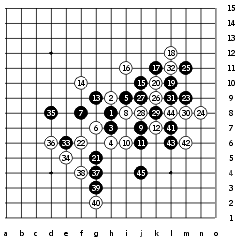 Nishizono - Zhang, 1:0, 45 moves Nishizono - Zhang, 1:0, 45 moves
In this game Nishizono demonstrated his power. 10(!?) is definitely an
interesting move, but 11(!) is a dignified answer. Maybe 16 was weak, in
my opinion 16-26 would be better, black can act very openly now. 22(?) -
doesn't in fact close anything. 30, 32(?) - such position of the stones
gives such an important point to black as 43. Norio took advantage of it
and led the game firmly towards a win. |
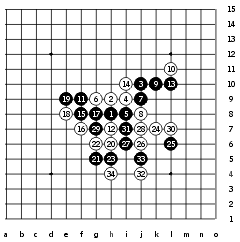 Hayakawa - Sagara, 0:1, 34 moves Hayakawa - Sagara, 0:1, 34 moves
Hayakawa, who very successfully battled against Europeans, played
really unsuccessfully with other Japanese. A game with Sagara was no
exception. 12(!) - on Russia's qualification tournament 12-17 was
constantly played, which seemed to be weaker. 13(?) - the idea of this
move is not clear. It seems that black would like to do something on the
right wing, but after that changes his mind and turns back to left. This
kind of behaviour was of course a good opportunity for Sagara. 16(!) -
white already takes over the initiative. 19(?) is total capitulation. Why
not 19-22?
20(!) - and black's position is already hopeless.
|
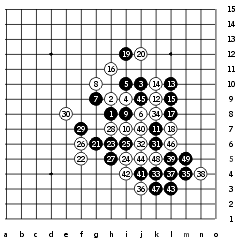 Sagara - Nishizono, 1:0, 49 moves Sagara - Nishizono, 1:0, 49 moves
Sagara succeeded in playing D3 for 9 times on the tournament. He was
black for 5 times and every time he placed this 5th move. The only one who
did not accept this was Zhang. Karlsson and Nishizono decided to proceed
to old and known paths on the 10th move, Sinyov and Makarov on the other
hand act resolutely. However, it didn't bring any luck to Nishizono, he
was the only one to accept the defeat. 17(!) - I honestly don't know a win
even after 18-A, although it's said to exist. So if anyone knows it, he
could send it to RW. |
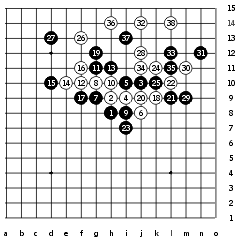 Sagara - Makarov, 0:1, 38 moves Sagara - Makarov, 0:1, 38 moves
Makarov had probably prepared himself carefully for the game. It wasn't
very difficult to guess which variant Sagara would play. Starting from the
26th move the game is something to enjoy for those who consider prohibited
black moves as the most exciting part of renju.
Still, the latter arose
a large number of questions for me. For example, if black plays first
25-26, then 27-25, how does white continue? I also did not find a win for
white if black moves 19-A. Maybe Makarov or Sagara can help me here?
If
white has no forced win, then the 13th move is good, because white is able
to handle black's positional pressure (Sinyov succeeded to subdue Sagara
after the 60th move, though there was also played 13-13, but then 14-16.
Sagara made quite many weak moves in the end of that game). |
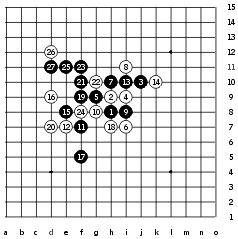 Hayakawa - Soosõrv, 1:0, 27 moves Hayakawa - Soosõrv, 1:0, 27 moves
Before the tournament I considered Hayakawa to be a little weaker than
the other Japanese players. In reality Hayakawa was the only one I lost
to...
7(?!) - After that Ando Meritee played three times 8-9 on last WC
and won all of the games. But I know tis variant badly and 8-8 suits my
peaceful style better. 11(!) is a strong move in my opinion. It provokes
white to attack, but both 12-13 and 12-A allow black to place his stones
outwards and get a more perspective position later on. 12(!) - white
continues with his plan. 13,15 - belac decides to start settling accounts
and thanks to 16(??) he succeeded. After 16-19 black's position would be
rather sad.
17(!) was the winning move. If 18-B then follows 19-C and
21-D. If 18-C, then 19-18 and 21-E. After 18-18 black has the possibility
to choose how to win. |
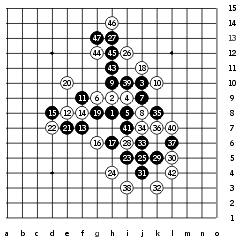 Soosõrv - Sagara, 1:0, 47 moves Soosõrv - Sagara, 1:0, 47 moves
After losing to Hayakawa in the first round I thought that it would be
better to play D3 with black and so in the third round against Sagara I
made the first reverse in my life in this opening. At that moment Sagara
shared the second place in the tournament table with 1.5 points and no one
had a clue about him being in undershape. 18(?!) - white's activity at
that time seems dangerous, because 19(!) followed and black took the
initiative straight away. During the game I thought that 24 should have
been played to h5 and after 25(!) there would be no defense. White really
can't play in a passive way anymore, but Sagara found beautiful 26(!).
After 27-L9 would follow 28-g12 and 30-h12, and after that for example
32-e12, 34-e9, 36-d10. Now black is forced to play out fours to defend and
there's no win anymore. Still it appeared that after a peaceful closing
move 27-27 white can't defend, because simple 35(!) was found, after what
I can't show a move for white. If 36-37, 39-42, 41-A and white's fours
can't save the position. To get a control, white should obviously play
16-B. |
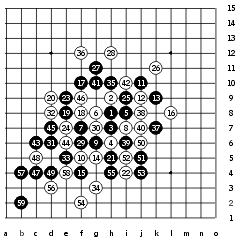 Sushkov - Soosõrv, 1:0, 55 moves Sushkov - Soosõrv, 1:0, 55 moves
Being smart afterwards I must mention that this variant is not good for
WC finals. Volodya skilfully made use of every connection in the position
and won deservedly.
19-21 doesn't help either. In the end the opponent
had only 2 minutes left of thinking time and I hoped that maybe he would
play 47-49, after what I could move 48-47 myself and onwards I have a
possibility to defend effectively, but Sushkov was firmness itself...
|
|
|